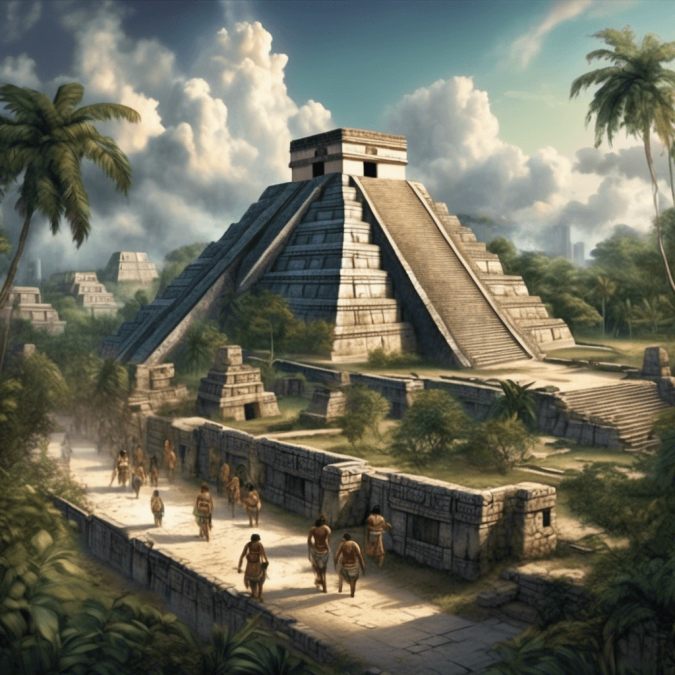
The Maya civilization was an ancient Mesoamerican civilization that thrived in the Yucatan Peninsula and Central America from around 2000 BC to 1500 AD. They were known for their advanced knowledge in astronomy, mathematics, and writing system. The Maya built impressive cities with grand temples and palaces, and their society was highly organized with a complex political system. They practiced agriculture, trading, and had a hierarchical society with a ruling elite. The Maya developed a calendar system and made significant advancements in architecture and art. However, around the 9th century, many Maya cities collapsed, and the civilization went into decline. The reasons for their downfall are still debated, but factors like warfare, environmental degradation, and political instability are believed to have contributed. Today, the Maya civilization continues to fascinate archaeologists and researchers, and their cultural legacy can still be seen in the traditions and languages of modern-day Maya communities.
In addition to their intellectual achievements, the Maya were also known for their religious practices. They believed in a complex pantheon of gods and goddesses and performed elaborate rituals to appease them. The Maya believed that the gods controlled every aspect of their lives, from agriculture and fertility to warfare and death. They built temples and pyramids as sacred spaces for these religious ceremonies, often sacrificing animals or even humans as offerings to the gods.
The Maya had a system of writing called hieroglyphics, which they used to record important events and keep historical records. They wrote on various materials such as bark paper, ceramics, and stone. The Maya writing system was incredibly intricate and consisted of over 800 different glyphs, each representing a specific word, sound, or concept. It wasn’t until the 20th century that archaeologists were able to decipher the Maya script, allowing us to gain a deeper understanding of their history and culture.
The Maya also had a highly developed understanding of astronomy. They carefully observed the movements of celestial bodies and developed a calendar system that was incredibly accurate. Their calendar consisted of multiple cycles, including the Long Count, which measured time in increments of 20 days, 360 days, and 7,200 days. This allowed them to predict astronomical events such as eclipses and solstices, and they used their calendar to plan important religious ceremonies and agricultural activities.
Despite the decline of their civilization, the Maya people continue to exist today. There are still many indigenous Maya communities in Mexico, Guatemala, Belize, and Honduras, who maintain their traditional languages and cultural practices. The legacy of the ancient Maya can be seen in their descendants’ art, architecture, agriculture, and spiritual beliefs. Archaeologists continue to study and excavate Maya sites, uncovering new insights into this once-thriving civilization.
The Maya civilization was known for its impressive architecture and city planning. They built large, well-organized cities with monumental structures such as pyramids, temples, and palaces. These structures were often adorned with intricate carvings and sculptures depicting gods, rulers, and important events. Some of the most famous Maya sites include Tikal and Chichen Itza, which are UNESCO World Heritage sites and major tourist attractions today.
The Maya were also skilled farmers and developed advanced agricultural techniques. They built raised fields and terraces to maximize their crop yields, and they cultivated a variety of crops, including maize (corn), beans, squash, and cacao. The Maya also had an extensive trade network, exchanging goods such as jade, obsidian, and textiles with neighboring civilizations.
One of the most unique aspects of Maya culture was their ballgame, known as pok-a-tok. This was a ritualistic sport played with a rubber ball on a stone court. The game had religious and symbolic significance, and it was often associated with human sacrifice.
The decline of the Maya civilization is a topic of much speculation and debate among scholars. It is believed that a combination of factors contributed to their downfall, including warfare, political instability, environmental degradation, and social unrest. The collapse of major Maya cities around the 9th century AD marked the end of the Classic Maya period. However, smaller Maya communities continued to thrive in the region, and the Maya civilization underwent a period of reorganization and cultural transformation.
Today, the Maya people continue to preserve their cultural heritage and traditions. Many Maya communities maintain their ancestral languages, traditional weaving and craft techniques, and spiritual beliefs. The Maya calendar and astronomical knowledge still hold significance in their cultural practices. In recent years, there has been a resurgence of interest in Maya culture, and archaeological discoveries continue to shed light on this fascinating ancient civilization.
